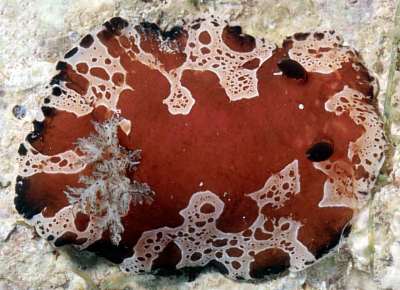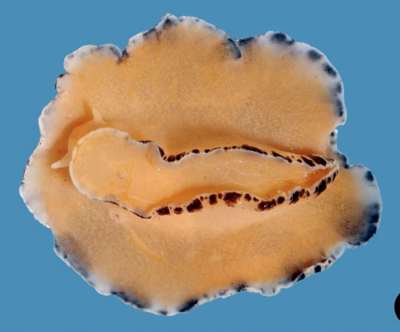

Platydoris dierythros
Fahey & Valdés, 2003.
Order: NUDIBRANCHIA
Suborder: DORIDINA
Superfamily: EUDORIDOIDEA
Family: Dorididae
DISTRIBUTION
Known only from NW Australia and Northern Territory, Australia.
PHOTO
Port Hedland, 15 m, Western Australia, Indian Ocean, 3 August 2000. Length: 40 mm. Holotype. Photographer: Clay Bryce.
The background colour of the mantle is cream. There is a large, irregular blotch of bright brownish red that covers most of the dorsum. Nearer to the edge of the mantle are smaller, irregular blotches of the same color. Along the edge of the mantle are small, irregular black spots. These black spots are also found on the underside of the mantle, along the lateral edges, but not in the anterior ventral area. The rhinophores are maroon with a black club and white tip. The gill branches are white with black irregular markings. The ventral color is cream with dark blotches along the edge of the foot. The oral tentacles are also cream.
Platydoris dierythros is readily distinguished by its bright brownish red splashes of color covering the cream background of the dorsum. This bright colour pattern with overlaying black spots along the mantle edge is not found on any other Indo-Pacific species of Platydorididae. Although some species of Platydoris may have a bright red color on the dorsum such as the eastern Atlantic and Mediterranean species Platydoris argo (Linnaeus, 1767), the background color in that species is not cream and there are no black spots along the mantle edge (Dorgan et al. 2002). Platydoris scabra (Cuvier, 1804) and P. cruenta (Quoy and Gaimard, 1832) can have a cream background color, but the irregular markings on the dorsum range from brown, to purple or gray on P. scabra (Dorgan et al. 2002). Platydoris cruenta can have red blotches on the dorsum, but there are accompanying wavy brown lines (Dorgan et al. 2002). Platydoris dierythros does not have these wavy brown lines. Platydoris formosa (Alder and Hancock, 1864) has a background color of whitish-cream with red blotches that are larger near the center of the body (Dorgan et al. 2002). But in this species the ventral side is white with numerous large, bright orange red spots on the border of the mantle. Platydoris dierythros has no colored spots on the ventral side, except for the dark spots along the foot and mantle borders. Platydoris herdmani, Farran, 1905, collected from Sri Lanka (Ceylon) has a single, pale reddish-brown blotch marked with darker spots on the dorsum, with smaller spots near the mantle margins. Along the mantle edge are sub-dermal black spots. The ventral side of this species has faint, pale brown dots and the margins of the foot have darker brown markings (Farran 1905).
The rhinophore and gill colors of Platydoris dierythros also differ from other similarly colored species of Platydoris. The rhinophores of Platydoris dierythros are maroon with a black club while those of Platydoris argo are darker than the body color and sometimes black, as is the gill (Dorgan et al. 2002). The rhinophores of P. scabra are yellow with dark orange tips and P. cruenta has rhinophores the same color as the dorsum and they are covered with brown lines. The gill of P. scabra is white with irregular dark lines on the rachises of the lamellae and the gill of P. cruenta is the same color or darker than the dorsum and covered with brown lines. Platydoris formosa has rhinophores that are uniformly red, with the tips slightly lighter. The gills of this species are cream with dark lines along the rachis. In addition to the unique external color characters of Platydoris dierythros, there is a combination of internal anatomical features which sets this new species apart from other described Platydoris species. You can see examples of P. dierythros in Willan and Coleman, 1984, Plate 107 and in Coleman, 1989, pg 22, middle figure.
The new species Platydoris dierythros shares several characteristics with other species of Indo-Pacific Platydoris and clearly belongs to this genus. Those characters include a flat body shape, the dorsum covered by small caryophyllidia, a wide mantle margin, a two-part prostate, a penis armed with hooks, a lobate accessory gland, a smooth labial cuticle and hamate radular teeth. Other characters that distinguish this as a new species include the absence of vaginal hooks, fimbriate outer lateral teeth and the accessory gland positioned on the side of the deferent duct. It grows to at least 70 mm in length.
-
Fahey, S. and Valdés, A. 2003. A new species of Platydoris (Mollusca: Nudibranchia) from North-Western Australia. [In] Wells, F.E., Walker, D.I., and Jones, D.S. The Marine Flora and Fauna of Dampier, Western Australia. Western Australian Museum, Perth.
Fahey, S. and Valdés, A., 2006 (March 14) Platydoris dierythros Fahey & Valdés, 2003.. [In] Sea Slug Forum. Australian Museum, Sydney. Available from http://www.seaslugforum.net/find/platdier
Related messages
New Platydoris species
March 15, 2006
From: Shireen Fahey
Hi Bill,
Speaking of the new Platydoris species (message #16042), I wondered if you had remembered the new Platydoris species from North-Western Australia that I sent to you a couple of years back?
-
Fahey, S. and Valdés, A. 2003. A new species of Platydoris (Mollusca: Nudibranchia) from North-Western Australia. [In] Wells, F.E., Walker, D.I., and Jones, D.S. The Marine Flora and Fauna of Dampier, Western Australia. Western Australian Museum, Perth.
Regards,
Shireen
sfahey@calacademy.org
Fahey, S., 2006 (Mar 15) New Platydoris species. [Message in] Sea Slug Forum. Australian Museum, Sydney. Available from http://www.seaslugforum.net/find/16087Dear Shireen,
I have just posted the Fact Sheet on P. dierythros. Unfortunately during the many months I was not allowed to work on the Forum quite a backlog of material built up. I am gradually dealing with it, but as you can imagine it all takes time. It was not forgotten - just waiting patiently.
Best wishes,
Bill Rudman
